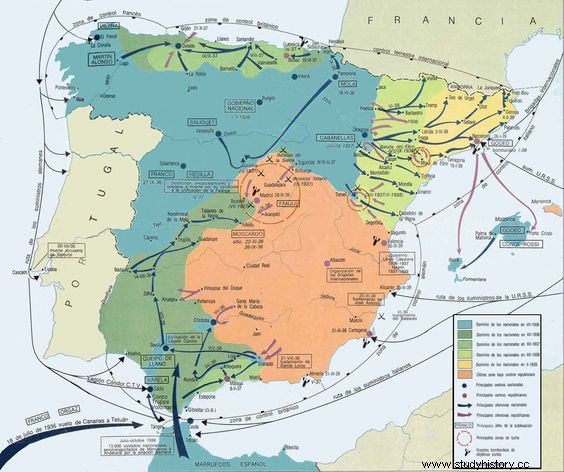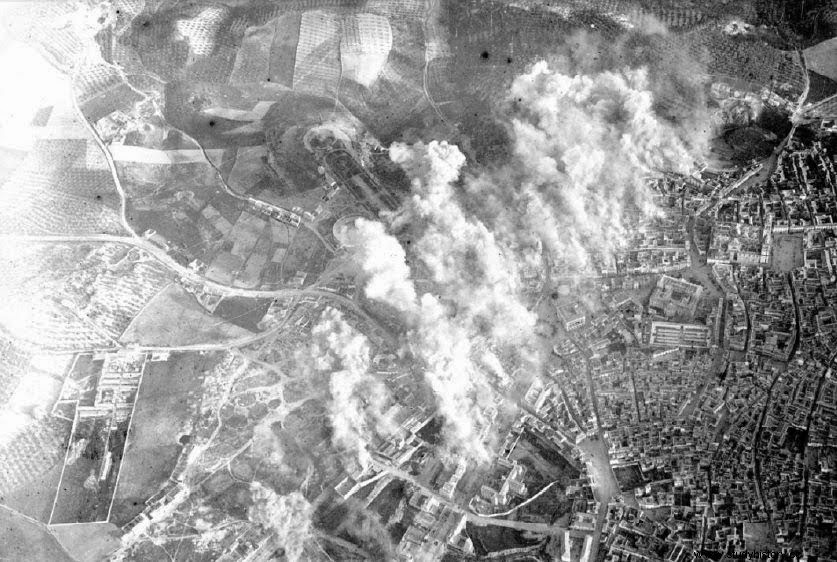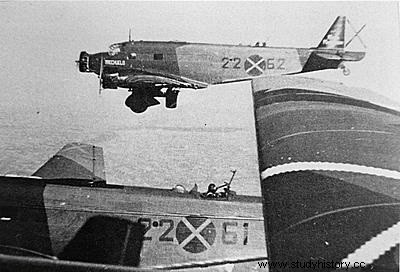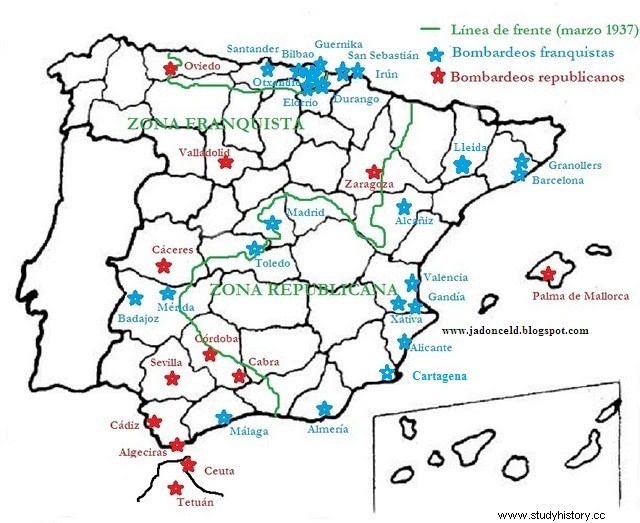The coup d'état of July 18 failed to succeed in the province of Jaén due to the strength of the labor movement, the scarcity of military personnel and the fact that the Republican militias managed to arm themselves by assaulting the Civil Guard barracks. The main confrontation took place in the Sanctuary of Our Lady of the Head, near Andújar, where the Republican troops besieged a group of Civil Guards and about a thousand civilians for nine months. Until April 1937, the city of Jaén had remained calm since it lacked strategic interest. From the beginning of 1937, the combat front remained immovable in a line that practically coincided with the limits of the provinces of Córdoba and Granada.

The tranquility was shattered on April 1, 1937, when the city suffered an intense aerial bombardment. It was carried out by planes from the Condor Legion, a German air contingent that was fighting allied with Franco's national troops, but piloted by Spanish aviators. The balance of victims reached the figure of 157 dead and about 280 wounded, all civilians and many of them children. As there were no defined military objectives, the bombing was indiscriminate on the city and had all the characteristics of a punishment and revenge operation.

The city was not a prominent military enclave and was not close to the front lines of combat, so it did not have anti-aircraft defenses or any alarm system. The speed of the attack caught the republican military commanders off guard who did not notify their air force to provide them with some defense. The bombing took place at 5:20 in the afternoon in a single pass by six Ju-52 bombers from the Tablada base (Seville). This aircraft was a transport trimotor but was also used in a bomber version. According to some sources, they were escorted by several Fiat CR-32 fighters, of Italian origin, and Heinkel 51, of German origin.

It was a retaliatory operation ordered by General Queipo de Llano in response to the bombing of Córdoba by Republican aviation that had occurred that same day. This had been one of the many bombardments that the caliphal city suffered – almost forty – although this time the action caused some 40 victims. It was carried out by Tupolev SB “Katiuskas” aircraft, light bombers of Soviet origin, which focused their objectives on the Military Hospital, the Artillery barracks and the station area. Other areas of the city were also affected, although to a much lesser extent.
The consequences of the bombing of Jaén aroused the population's hatred and desire for revenge. Thus, the Provincial Committee of the Popular Front decided to shoot, in retaliation, as many national prisoners – clerics, militants of right-wing parties, etc. – as victims had caused the bombing. In the following days and until April 7, 128 prisoners were shot, taken from the Provincial Prison and the Cathedral, which was also used as a jail.
Although the rejection of the bombing spread both in the Republican zone and abroad, as well as the signs of solidarity, the event was soon relegated to the background. The outcry over the bombing of Durango, carried out by the Italian Legionary Aviation on March 31 and which caused 336 victims and the subsequent bombing of Guernica – this one carried out by the German Condor Legion on April 26 and which caused 126 victims -, Hugely publicized and used by the republican government to denounce the cruelty of the national side and its German allies, they ended up eclipsing the bombing of Jaén. Both sides drew a thick veil over this fact:the nationals because they were aware of its barbarism and the Republicans because they knew that the removals that occurred later were not justifiable in any way. For all these reasons, time was eclipsing the memory of this bombing which, as such, reached the same level of tragedy as those mentioned above.
In many aspects, the Spanish war was a prelude to what happened later in the Second World War. One of those aspects was that of military strategies. The tactic of indiscriminate aerial bombardment of cities located in the rear was inaugurated in Spain; The aim was not to destroy military objectives – barracks, arsenals, communication hubs, ports, airports, etc. – but rather to attack the civilian population in order to demoralize the enemy.
The first large-scale bombings were suffered by Madrid from November 1936 and later other cities, both national and republican, would suffer them. It can be affirmed that the national forces were the ones that most profusely used this tactic, especially from the spring of 1937. The objective of these attacks was twofold:on the one hand a demonstration of power and, on the other, as we have already pointed out, cause demoralization and panic in the enemy rear. At the same time, the most effective war tactics were studied –attack formations, types of bombs, aircraft,…– and new models of bombs and devices were tested.

The bombing of Jaén is inscribed in the catalog of these actions but unlike the bombings of Durango or Guernica, whose attacks must be contextualized in the offensive that the national troops carried out against Bilbao, that of Jaén was not planned or linked with no military offensive. He only responded to the hot and vindictive decision of General Queipo de Llano.
Bibliography.
Cardona, G. (2006). Military history of a civil war:strategies and tactics of the war in Spain . Barcelona:Flower of the Wind.
Cuevas Mata, J. (2013). The bombardment of Jaén, April 1, 1937 . Jaén:Association for the Recovery of the Historical Memory of Jaén.
Doncel, J.A.D. (2012). Aerial bombings in the Spanish civil war:The destruction of Guernica. Retrieved on 04/20/2017 from http://jadonceld.blogspot.com.es/2012/01/bombardeos-aereos-en-la-guerra-civil.html
Hidalgo, P. (sf). The republican aerial bombardments on the national rearguard during the Spanish civil war:an approach to the case of Córdoba. Retrieved April 22, 2017, from http://www.laguerracivilencordoba.es/intro.htm
Linde, R. (2015). The bombing of Jaén. Retrieved from https://blogdehistoriaderafa.wordpress.com/2015/03/26/el-bombardeo-de-jaen/
Luzarraga, I. (2008). Shelters of life for Gernika. The Mail . Retrieved April 22, 2017, from http://www.elcorreo.com/vizcaya/20080427/costa/refugios-vida-para-gernika-20080427.html
Martín Alarcón, J. (sf). The bombing of Jaén in 1937:more dead than in Guernica a month before. The Confidential . Retrieved April 20, 2017, from http://www.elconfidencial.com/cultura/2017-04-01/guerra-civil-bombardeo-jaen-1937-guernica_1359031
